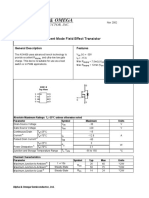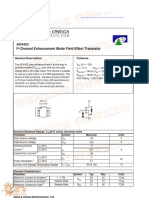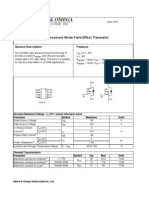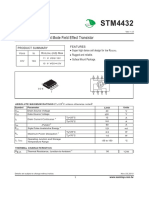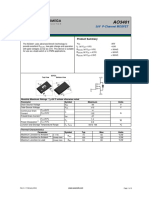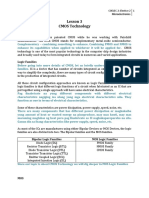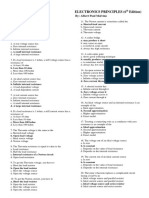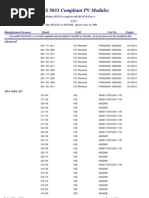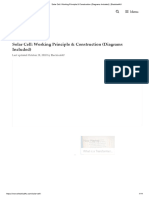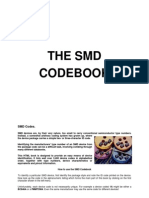AO4441 P-Channel Enhancement Mode Field Effect Transistor: Features General Description
AO4441 P-Channel Enhancement Mode Field Effect Transistor: Features General Description
Uploaded by
Mie Hijau Tanpa PengawetCopyright:
Available Formats
AO4441 P-Channel Enhancement Mode Field Effect Transistor: Features General Description
AO4441 P-Channel Enhancement Mode Field Effect Transistor: Features General Description
Uploaded by
Mie Hijau Tanpa PengawetOriginal Title
Copyright
Available Formats
Share this document
Did you find this document useful?
Is this content inappropriate?
Copyright:
Available Formats
AO4441 P-Channel Enhancement Mode Field Effect Transistor: Features General Description
AO4441 P-Channel Enhancement Mode Field Effect Transistor: Features General Description
Uploaded by
Mie Hijau Tanpa PengawetCopyright:
Available Formats
AO4441
P-Channel Enhancement Mode Field Effect Transistor
General Description Features
The AO4441 uses advanced trench technology to VDS (V) = -60V
provide excellent RDS(ON), and ultra-low low gate ID = -4 A (VGS = -10V)
charge. This device is suitable for use as a load RDS(ON) < 100mΩ (VGS = -10V)
switch or in PWM applications. Standard Product RDS(ON) < 130mΩ (VGS = -4.5V)
AO4441 is Pb-free (meets ROHS & Sony 259
specifications). AO4441L is a Green Product
ordering option. AO4441 and AO4441L are
electrically identical.
D
SOIC-8
Top View
S D
S D
S D G
G D S
Absolute Maximum Ratings TA=25°C unless otherwise noted
Parameter Symbol Maximum Units
Drain-Source Voltage VDS -60 V
Gate-Source Voltage VGS ±20 V
Continuous Drain TA=25°C -4
Current A TA=70°C ID -3.1 A
B
Pulsed Drain Current IDM -20
TA=25°C 3.1
PD W
Power Dissipation A TA=70°C 2
Junction and Storage Temperature Range TJ, TSTG -55 to 150 °C
Thermal Characteristics
Parameter Symbol Typ Max Units
Maximum Junction-to-Ambient A t ≤ 10s 24 40 °C/W
RθJA
Maximum Junction-to-Ambient A Steady-State 54 75 °C/W
Maximum Junction-to-Lead C Steady-State RθJL 21 30 °C/W
Alpha & Omega Semiconductor, Ltd.
AO4441
P-Channel Electrical Characteristics (TJ=25°C unless otherwise noted)
Symbol Parameter Conditions Min Typ Max Units
STATIC PARAMETERS
BVDSS Drain-Source Breakdown Voltage ID=-250µA, VGS=0V -60 V
VDS=-48V, VGS=0V -1
IDSS Zero Gate Voltage Drain Current µA
TJ=55°C -5
IGSS Gate-Body leakage current VDS=0V, VGS=±20V ±100 nA
VGS(th) Gate Threshold Voltage VDS=VGS ID=-250µA -1 -2.1 -3 V
ID(ON) On state drain current VGS=-10V, VDS=-5V -20 A
VGS=-10V, ID=-4A 80 100
mΩ
RDS(ON) Static Drain-Source On-Resistance TJ=125°C 130
VGS=-4.5V, ID=-3A 102 130 mΩ
gFS Forward Transconductance VDS=-5V, ID=-4A 10 S
VSD Diode Forward Voltage IS=-1A,VGS=0V -0.77 -1 V
IS Maximum Body-Diode Continuous Current -4 A
DYNAMIC PARAMETERS
Ciss Input Capacitance 930 1120 pF
Coss Output Capacitance VGS=0V, VDS=-30V, f=1MHz 85 pF
Crss Reverse Transfer Capacitance 35 pF
Rg Gate resistance VGS=0V, VDS=0V, f=1MHz 7.2 9 Ω
SWITCHING PARAMETERS
Qg(10V) Total Gate Charge (10V) 16 20 nC
Qg(4.5V) Total Gate Charge (4.5V) 8 10 nC
VGS=-10V, VDS=-30V, ID=-4A
Qgs Gate Source Charge 2.5 nC
Qgd Gate Drain Charge 3.2 nC
tD(on) Turn-On DelayTime 8 ns
tr Turn-On Rise Time VGS=-10V, VDS=-30V, RL=7.5Ω, 3.8 ns
tD(off) Turn-Off DelayTime RGEN=3Ω 31.5 ns
tf Turn-Off Fall Time 7.5 ns
trr Body Diode Reverse Recovery Time IF=-4A, dI/dt=100A/µs 27 35 ns
Qrr Body Diode Reverse Recovery Charge IF=-4A, dI/dt=100A/µs 32 nC
2
A: The value of R θJA is measured with the device mounted on 1in FR-4 board with 2oz. Copper, in a still air environment with TA =25°C. The
value in any ien
given
application
application
depends
dependson on
thethe
user's
user's
specific
specific
board
board
design.
design.
TheThe
current
current
rating
rating
is based
is based
on on
thethe
t ≤ 10s
t ≤ 10s
thermal
thermal
resistance
resistance
rating.
B: Repetitive rating, pulse width limited by junction temperature.
C. The R θJA is the sum of the thermal impedence from junction to lead RθJL and lead to ambient.
D. The static characteristics in Figures 1 to 6,12,14 are obtained using 80 µs pulses, duty cycle 0.5% max.
E. These tests are performed with the device mounted on 1 in 2 FR-4 board with 2oz. Copper, in a still air environment with TA=25°C. The
SOA curve provides a single pulse rating.
THIS PRODUCT HAS BEEN DESIGNED AND QUALIFIED FOR THE CONSUMER MARKET. APPLICATIONS OR USES AS CRITICAL
COMPONENTS IN LIFE SUPPORT DEVICES OR SYSTEMS ARE NOT AUTHORIZED. AOS DOES NOT ASSUME ANY LIABILITY ARISING
OUT OF SUCH APPLICATIONS OR USES OF ITS PRODUCTS. AOS RESERVES THE RIGHT TO IMPROVE PRODUCT DESIGN,
FUNCTIONS AND RELIABILITY WITHOUT NOTICE Rev 1: Sept 2005
Alpha & Omega Semiconductor, Ltd.
AO4441
TYPICAL ELECTRICAL AND THERMAL CHARACTERISTICS: P-CHANNEL
20 10
-10V -4.5V VDS=-5V
-5.0V 8
15 -4.0V
-6.0V
6
-ID (A)
-ID(A)
10
-3.5V
4
125°C
5
VGS=-3.0V 2
25°C
0
0
0 1 2 3 4 5
1 1.5 2 2.5 3 3.5 4
-VDS (Volts)
-VGS(Volts)
Fig 1: On-Region Characteristics
Figure 2: Transfer Characteristics
110 2
VGS=-4.5V
Normalized On-Resistance
1.8 VGS=-10V
100 ID=-4A
1.6
RDS(ON) (mΩ)
1.4 VGS=-4.5V
90
ID=-3A
ID=-3A
1.2
80 VGS=-10V
1
0.8
70 0 25 50 75 100 125 150 175
0 2 4 6 8 10
Temperature (°C)
-ID (A) Figure 4: On-Resistance vs. Junction
Figure 3: On-Resistance vs. Drain Current and Temperature
Gate Voltage
200 1.0E+01
ID=-4A
180 1.0E+00
160 125°C 125°C
1.0E-01
RDS(ON) (mΩ)
140 1.0E-02
-IS (A)
120
1.0E-03
100
1.0E-04
25°C
80 25°C
1.0E-05
60
2 4 6 8 10 1.0E-06
0.0 0.2 0.4 0.6 0.8 1.0
-VGS (Volts)
Figure 5: On-Resistance vs. Gate-Source Voltage -VSD (Volts)
Figure 6: Body-Diode Characteristics
Alpha & Omega Semiconductor, Ltd.
AO4441
TYPICAL ELECTRICAL AND THERMAL CHARACTERISTICS: P-CHANNEL
10 1500
VDS=-30V
ID=-4A
8
Ciss
Capacitance (pF)
1000
-VGS (Volts)
4
500
2 Coss Crss
0
0
0 10 20
0 10 20 30 40 50 60
-Qg (nC)
-VDS (Volts)
Figure 7: Gate-Charge Characteristics
Figure 8: Capacitance Characteristics
100.0
40
TJ(Max)=150°C, TA=25°C TJ(Max)=150°C
TA=25°C
RDS(ON) 30
10.0 limited 100µs 10µs
-ID (Amps)
Power (W)
1ms
20
10ms
1.0 0.1s
1s 10
10s DC
0.1 0
0.001 0.01 0.1 1 10 100 1000
0.1 1 10 100
-VDS (Volts) Pulse Width (s)
Figure 9: Maximum Forward Biased Safe Figure 10: Single Pulse Power Rating Junction-to-
Operating Area (Note E) Ambient (Note E)
10
D=Ton/T In descending order
TJ,PK=TA+PDM.ZθJA.RθJA D=0.5, 0.3, 0.1, 0.05, 0.02, 0.01, single pulse
ZθJA Normalized Transient
RθJA=40°C/W
Thermal Resistance
PD
0.1
Ton
T
Single Pulse
0.01
0.00001 0.0001 0.001 0.01 0.1 1 10 100 1000
Pulse Width (s)
Figure 11: Normalized Maximum Transient Thermal Impedance
Alpha & Omega Semiconductor, Ltd.
You might also like
- Ao 4435Document4 pagesAo 4435LUISNo ratings yet
- AO4407 P-Channel Enhancement Mode Field Effect Transistor: Features General DescriptionDocument4 pagesAO4407 P-Channel Enhancement Mode Field Effect Transistor: Features General Descriptionedi purwantoNo ratings yet
- Ao3407 AoDocument7 pagesAo3407 AoBenjaminNo ratings yet
- AO4409 P-Channel Enhancement Mode Field Effect Transistor: Features General DescriptionDocument6 pagesAO4409 P-Channel Enhancement Mode Field Effect Transistor: Features General DescriptionShamim DhaliNo ratings yet
- General Description Product Summary: 60V P-Channel MOSFETDocument5 pagesGeneral Description Product Summary: 60V P-Channel MOSFETdario defazyNo ratings yet
- AO3401 P-Channel Enhancement Mode Field Effect Transistor: Features General DescriptionDocument4 pagesAO3401 P-Channel Enhancement Mode Field Effect Transistor: Features General DescriptionAbdul MuhidNo ratings yet
- Shenzhen Tuofeng Semiconductor Technology Co., LTD: 4803 Dual P-Channel Enhancement Mode Field Effect TransistorDocument4 pagesShenzhen Tuofeng Semiconductor Technology Co., LTD: 4803 Dual P-Channel Enhancement Mode Field Effect TransistorshareephabdullaNo ratings yet
- AO3413 P-Channel Enhancement Mode Field Effect Transistor: Features General DescriptionDocument5 pagesAO3413 P-Channel Enhancement Mode Field Effect Transistor: Features General Descriptionaffes electroniqueNo ratings yet
- Ao4433 1254836Document4 pagesAo4433 1254836Chithiran C SspNo ratings yet
- 785 1089 2 DatasheetzDocument7 pages785 1089 2 Datasheetzoswaldo220990No ratings yet
- 30V P-Channel MOSFET: Product Summary General DescriptionDocument5 pages30V P-Channel MOSFET: Product Summary General DescriptionAndrea CupelloNo ratings yet
- 30V P-Channel MOSFET: Product Summary General DescriptionDocument5 pages30V P-Channel MOSFET: Product Summary General DescriptionJelly Pin0% (1)
- AO3413 P-Channel Enhancement Mode Field Effect Transistor: Features General DescriptionDocument6 pagesAO3413 P-Channel Enhancement Mode Field Effect Transistor: Features General Descriptionrahul sarkarNo ratings yet
- AO4422 Alpha & Omega SemiconductorDocument5 pagesAO4422 Alpha & Omega SemiconductorMarcos NuñezNo ratings yet
- Product Summary General Description: 40V N-Channel MOSFETDocument4 pagesProduct Summary General Description: 40V N-Channel MOSFETsagarNo ratings yet
- Ao4468 PDFDocument5 pagesAo4468 PDFAxsoftSoporteNo ratings yet
- AO4466 N-Channel Enhancement Mode Field Effect Transistor: Features General DescriptionDocument4 pagesAO4466 N-Channel Enhancement Mode Field Effect Transistor: Features General DescriptionErick V. BlancoNo ratings yet
- Datasheet 3Document6 pagesDatasheet 3fenixtec1No ratings yet
- Product Summary General Description: 30V N-Channel MOSFETDocument4 pagesProduct Summary General Description: 30V N-Channel MOSFETKatarina ClaesNo ratings yet
- Ao4435 Power Mosfet - ImportantDocument5 pagesAo4435 Power Mosfet - ImportantSURESH CHANDRA ROUTNo ratings yet
- 4402 TuofengSemiconductorDocument6 pages4402 TuofengSemiconductorNam TàoNo ratings yet
- AOD407 P-Channel Enhancement Mode Field Effect Transistor: Features General DescriptionDocument6 pagesAOD407 P-Channel Enhancement Mode Field Effect Transistor: Features General Descriptionsuan kwang TanNo ratings yet
- Product Summary General Description: 30V P-Channel MOSFETDocument5 pagesProduct Summary General Description: 30V P-Channel MOSFETpglez93No ratings yet
- AO4470 N-Channel Enhancement Mode Field Effect Transistor: Features General DescriptionDocument4 pagesAO4470 N-Channel Enhancement Mode Field Effect Transistor: Features General DescriptionAdan Rodríguez SoaresNo ratings yet
- PL4009规格书Document4 pagesPL4009规格书Nemo StevoNo ratings yet
- Ao3413 PDFDocument5 pagesAo3413 PDFMohamed Ibrahim AhamedRasmiNo ratings yet
- AO8807 Dual P-Channel Enhancement Mode Field Effect TransistorDocument5 pagesAO8807 Dual P-Channel Enhancement Mode Field Effect TransistorSamerNo ratings yet
- Product Summary General Description: 30V N-Channel MOSFETDocument6 pagesProduct Summary General Description: 30V N-Channel MOSFETmegha vishwakarmaNo ratings yet
- AO3435 P-Channel Enhancement Mode Field Effect Transistor: Features General DescriptionDocument4 pagesAO3435 P-Channel Enhancement Mode Field Effect Transistor: Features General DescriptionBhadreshkumar SharmaNo ratings yet
- General Description: 30V N-Channel MOSFETDocument6 pagesGeneral Description: 30V N-Channel MOSFETFabian OrtuzarNo ratings yet
- Product Summary General Description: 30V N-Channel MOSFETDocument5 pagesProduct Summary General Description: 30V N-Channel MOSFETSudais AkbarNo ratings yet
- AON4407 12V P-Channel MOSFET: Features General DescriptionDocument5 pagesAON4407 12V P-Channel MOSFET: Features General DescriptionSamerNo ratings yet
- General Description Product Summary: 30V P-Channel MOSFETDocument5 pagesGeneral Description Product Summary: 30V P-Channel MOSFEThosahe765No ratings yet
- AO4496Document5 pagesAO4496peter notarianniNo ratings yet
- Ao 4456Document5 pagesAo 4456RAGANo ratings yet
- Ao3401 PDFDocument5 pagesAo3401 PDFWalter FabianNo ratings yet
- AOD413A P-Channel Enhancement Mode Field Effect Transistor: Features General DescriptionDocument6 pagesAOD413A P-Channel Enhancement Mode Field Effect Transistor: Features General DescriptionFabio Fabrega CervantesNo ratings yet
- AO4474 N-Channel Enhancement Mode Field Effect Transistor: Features General DescriptionDocument5 pagesAO4474 N-Channel Enhancement Mode Field Effect Transistor: Features General DescriptionGuillermo OrtizNo ratings yet
- Acer Aspire 4740 4745 5740 5745 - COMPAL LA-5681P - REV 1.0Document5 pagesAcer Aspire 4740 4745 5740 5745 - COMPAL LA-5681P - REV 1.0Ali AkbarNo ratings yet
- Shenzhen Tuofeng Semiconductor Technology Co., LTDDocument4 pagesShenzhen Tuofeng Semiconductor Technology Co., LTDRolando Omar NavarroNo ratings yet
- AO7408 N-Channel Enhancement Mode Field Effect Transistor: Features General DescriptionDocument4 pagesAO7408 N-Channel Enhancement Mode Field Effect Transistor: Features General DescriptionAri SugitoNo ratings yet
- Shenzhen Tuofeng Semiconductor Technology Co., LTD: FeaturesDocument7 pagesShenzhen Tuofeng Semiconductor Technology Co., LTD: FeaturesSamuel CelinNo ratings yet
- AO4812Document4 pagesAO4812Edson HenriqueNo ratings yet
- 20V P-Channel MOSFET: Features General DescriptionDocument5 pages20V P-Channel MOSFET: Features General DescriptionStoica VictorNo ratings yet
- AO4406 N-Channel Enhancement Mode Field Effect Transistor: Features General DescriptionDocument6 pagesAO4406 N-Channel Enhancement Mode Field Effect Transistor: Features General DescriptionzufNo ratings yet
- General Description Product Summary: 30V P-Channel MOSFETDocument5 pagesGeneral Description Product Summary: 30V P-Channel MOSFETAgusWinotoNo ratings yet
- Product Summary General Description: 30V N-Channel MOSFETDocument5 pagesProduct Summary General Description: 30V N-Channel MOSFETMafia BetawiNo ratings yet
- AO460 6 Complementary Enhancement Mode Field Effect TransistorDocument10 pagesAO460 6 Complementary Enhancement Mode Field Effect TransistorMohamed SaidNo ratings yet
- N-Channel Enhancement Mode Field Effect TransistorDocument7 pagesN-Channel Enhancement Mode Field Effect TransistorleomegonNo ratings yet
- AO4407A P-Channel Enhancement Mode Field Effect Transistor: Features General DescriptionDocument5 pagesAO4407A P-Channel Enhancement Mode Field Effect Transistor: Features General DescriptionВладислав ДубинаNo ratings yet
- AO4606 Complementary Enhancement Mode Field Effect TransistorDocument7 pagesAO4606 Complementary Enhancement Mode Field Effect TransistorkhafjiNo ratings yet
- Srfet: AO4456 N-Channel Enhancement Mode Field Effect TransistorDocument7 pagesSrfet: AO4456 N-Channel Enhancement Mode Field Effect TransistorFS motherboardsNo ratings yet
- FET Doble AO4604Document9 pagesFET Doble AO4604Antonio ChavezNo ratings yet
- AO4468 N-Channel Enhancement Mode Field Effect Transistor: Features General DescriptionDocument5 pagesAO4468 N-Channel Enhancement Mode Field Effect Transistor: Features General DescriptionDeddyNo ratings yet
- AO3401-Alpha & Omega SemiconductorsDocument5 pagesAO3401-Alpha & Omega SemiconductorsCristian BelliazziNo ratings yet
- AO4430, AO4430L (Green Product) N-Channel Enhancement Mode Field Effect TransistorDocument4 pagesAO4430, AO4430L (Green Product) N-Channel Enhancement Mode Field Effect TransistorRechard BroneNo ratings yet
- Ao3407 PDFDocument5 pagesAo3407 PDFMelissa MelissaNo ratings yet
- AO4466 N-Channel Enhancement Mode Field Effect Transistor: Features General DescriptionDocument6 pagesAO4466 N-Channel Enhancement Mode Field Effect Transistor: Features General DescriptionSebastian LunaNo ratings yet
- Design of Electrical Circuits using Engineering Software ToolsFrom EverandDesign of Electrical Circuits using Engineering Software ToolsNo ratings yet
- cdcm61002Document36 pagescdcm61002Mie Hijau Tanpa PengawetNo ratings yet
- AHC594Document28 pagesAHC594Mie Hijau Tanpa PengawetNo ratings yet
- ADP4100-DDocument23 pagesADP4100-DMie Hijau Tanpa PengawetNo ratings yet
- BCX 5616 QDocument6 pagesBCX 5616 QMie Hijau Tanpa PengawetNo ratings yet
- Service Manual: For Agilent Model 6611C, 6612C, 6613C, 6614C System DC Power SupplyDocument59 pagesService Manual: For Agilent Model 6611C, 6612C, 6613C, 6614C System DC Power SupplyMie Hijau Tanpa PengawetNo ratings yet
- Routerboard 951G - 2Hnd: Quick Setup Guide and Warranty Information ConnectingDocument3 pagesRouterboard 951G - 2Hnd: Quick Setup Guide and Warranty Information ConnectingMie Hijau Tanpa PengawetNo ratings yet
- Full-Lab-manual-Spring 2019Document39 pagesFull-Lab-manual-Spring 2019HarshiniNo ratings yet
- SemiconductorsDocument122 pagesSemiconductorsArpita JaiswalNo ratings yet
- Lesson 3 CMOS Technology Teacher'sDocument7 pagesLesson 3 CMOS Technology Teacher'sMaria Ana DanganNo ratings yet
- Module 6: Semiconductor Memories Lecture 28: Static Random Access Memory (SRAM)Document6 pagesModule 6: Semiconductor Memories Lecture 28: Static Random Access Memory (SRAM)shireesh12345No ratings yet
- 0 JTFSG 392 Deoq 0 RD 9 WW 5 Ya 14 PefyDocument2 pages0 JTFSG 392 Deoq 0 RD 9 WW 5 Ya 14 PefyruhyaningtiasNo ratings yet
- UEC750Document2 pagesUEC750Shivam SharmaNo ratings yet
- 06 Bipolar Junction TransistorsDocument57 pages06 Bipolar Junction Transistors陳浚維No ratings yet
- 8.slayt ElectrotechnicDocument34 pages8.slayt Electrotechnicserkan1234No ratings yet
- Datasheet of BAT48Document2 pagesDatasheet of BAT48Станислав ИвановNo ratings yet
- UNIT-3 Bipolar Junction Transistor (BJT)Document68 pagesUNIT-3 Bipolar Junction Transistor (BJT)laxmanNo ratings yet
- Mos Field Effect Transistor: Switching N-Channel Power Mos Fet Industrial UseDocument8 pagesMos Field Effect Transistor: Switching N-Channel Power Mos Fet Industrial UselvmottaNo ratings yet
- Malvino MCQDocument33 pagesMalvino MCQハンター ジェイソンNo ratings yet
- Thin-Film Solar CellDocument72 pagesThin-Film Solar CellPraveen KumarNo ratings yet
- Self StudyDocument14 pagesSelf StudyLyf AquaNo ratings yet
- E315 Parts ListDocument10 pagesE315 Parts ListChateando Con FernandoNo ratings yet
- SFR15F60T2/F2 - Datasheet: 15A, 600V Super-Fast Recovery RectifierDocument5 pagesSFR15F60T2/F2 - Datasheet: 15A, 600V Super-Fast Recovery RectifierАлександр Качеишвили100% (1)
- Electronics Device PDFDocument38 pagesElectronics Device PDFFariz Azhar AbdillahNo ratings yet
- Anneling of Pbs QDSCDocument7 pagesAnneling of Pbs QDSCAbhigyan GangulyNo ratings yet
- PIC18FDocument37 pagesPIC18Fsitizarina78No ratings yet
- Problems BJT DC AnalysisDocument2 pagesProblems BJT DC AnalysisSems KrksNo ratings yet
- 12EE2603 - Power Electronics: Department of Electrical and Electronics EngineeringDocument72 pages12EE2603 - Power Electronics: Department of Electrical and Electronics EngineeringMurughesh MurughesanNo ratings yet
- Electronic Device and Circuit Theory by Boylestad&NashelskyDocument2 pagesElectronic Device and Circuit Theory by Boylestad&NashelskyZackNo ratings yet
- PV Module List 100625Document101 pagesPV Module List 100625rayddi74No ratings yet
- VLSI Design ManualDocument45 pagesVLSI Design ManualRafeyNo ratings yet
- (Assignments 4) : I I I I IDocument3 pages(Assignments 4) : I I I I IAhmed JamalNo ratings yet
- Nanoscale Transistors: Device Physics, Modeling and SimulationDocument27 pagesNanoscale Transistors: Device Physics, Modeling and SimulationBhaskar KNo ratings yet
- Solar Cell - Working Principle & ConstructionDocument14 pagesSolar Cell - Working Principle & ConstructionT V V SIVA RAMA KUMARNo ratings yet
- Bom Udoo NeoDocument6 pagesBom Udoo NeoNguyễn Trần Minh TuấnNo ratings yet
- SMD Catalog222Document80 pagesSMD Catalog222khinderNo ratings yet
- Chapter 5 - Internal Memory: 5.1 Semiconductor Main Memory 5.2 Error CorrectionDocument14 pagesChapter 5 - Internal Memory: 5.1 Semiconductor Main Memory 5.2 Error CorrectionChu Quang HuyNo ratings yet



